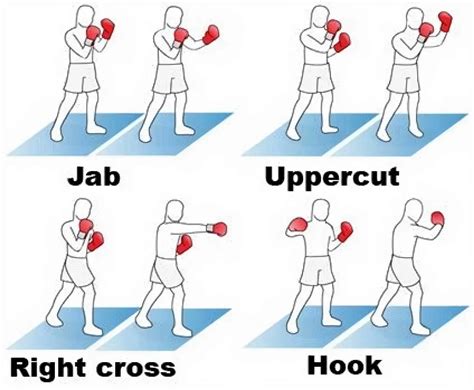Explore essential boxing techniques, from mastering the jab to effective footwork, and learn strategies for success in the ring. FAQs included!Boxing is a dynamic and demanding sport that requires both physical conditioning and technical skill. For beginners stepping into the ring, mastering fundamental techniques is essential for building a strong foundation and boosting confidence. In this article, we will explore the Top 10 Boxing Techniques Every Beginner Should Know, providing insights into their importance and practical applications. From establishing the basic stance to honing effective footwork and mastering the jab, each technique plays a crucial role in your boxing journey. Whether you’re training for fitness or aspiring to compete, understanding and employing these techniques will help you create winning strategies and elevate your performance. Join us as we dive into the fundamentals that will kickstart your success in the ring!
Understanding The Importance Of The Top 10 Boxing Techniques
Having a solid grasp of the Top 10 boxing techniques is essential for any beginner seeking to establish a strong foundation in the sport. These techniques not only enhance a boxer’s performance but also ensure their safety in the ring. Each technique contributes to a fighter’s overall skill set and is pivotal in various fights, regardless of the opponent’s style or experience level.
Here are a few key reasons why understanding these techniques is crucial:
| Importance | Description |
|---|---|
| Foundation Skills | The Top 10 techniques provide essential skills that all successful boxers share, allowing beginners to build on these fundamentals. |
| Injury Prevention | Proper technique reduces the risk of injury. By mastering the basics, beginners can train harder and longer without putting themselves at risk. |
| Confidence Building | Understanding and practicing these techniques helps beginners build confidence, enabling them to enter the ring with a winning mindset. |
| Strategic Execution | Mastering these techniques allows fighters to think strategically during their matches, enabling them to adapt to various opponents and situations. |
Focusing on the Top 10 boxing techniques is not just a matter of skill development; it is about laying the groundwork for a successful and safe boxing journey. Embracing these fundamentals can lead to improvements in technique, confidence, and overall performance in the ring.
Basic Stance: Setting The Foundation For Success
In boxing, the foundational element that can significantly impact your performance is your stance. A proper stance not only helps you maintain balance but also prepares you for effective offense and defense. Understanding how to position your body can be the difference between winning and losing a match.
The basic boxing stance involves standing with your feet shoulder-width apart. Your dominant foot should be slightly back, maintaining a balanced weight distribution. Your knees should be slightly bent, allowing for quick movements in any direction. This stance not only stabilizes your body but also positions you for powerful punches while keeping you ready to evade incoming strikes.
To maximize your stance effectiveness, follow these key points:
- Feet placement: Ensure your lead foot is pointing forward while your rear foot is angled slightly outward.
- Weight distribution: Keep your weight evenly distributed to ensure stability and mobility.
- Guard position: Maintain a high guard with your hands up to protect your face while still being able to throw punches quickly.
Practicing your stance regularly can enhance your reflexes and response time in the ring, making it one of the top 10 techniques every beginner should master. Ultimately, a strong stance will set the stage for developing other vital boxing techniques, helping you become a more effective fighter in the long run.
Effective Footwork: Moving With Purpose In The Ring
Footwork is a fundamental aspect of boxing that often gets overlooked by beginners. However, mastering effective footwork is essential for both offense and defense, allowing you to position yourself optimally in the ring. Here are some key concepts to help you understand and develop your footwork skills:
- Balance: Always maintain a balanced stance to ensure quick movements in any direction. This will help you stay stable while delivering punches and avoiding incoming blows.
- Foot Placement: Pay attention to where your feet are positioned. Keep your feet shoulder-width apart, and ensure that your lead foot is slightly ahead of your rear foot. This enables quicker, more agile movements.
- Movement Types: Incorporate various types of movements, such as lateral, diagonal, and backward shifts. Practicing these movements will make you more unpredictable and difficult to hit.
- Using Your Toes: When moving, use the balls of your feet rather than your heels. This allows for faster, more reactive movements and better control over your direction.
- Shadowboxing: Regularly practice footwork during shadowboxing sessions. Focus on moving in and out and side-to-side while throwing punches to create muscle memory.
- Practice Drills: Engage in footwork drills, such as ladder drills or cone exercises, to enhance agility and coordination. These drills can help improve your speed and precision in the ring.
By focusing on these essential elements of footwork, you will gain the ability to maneuver effectively, making it one of the top 10 boxing techniques that every beginner should prioritize. Remember, effective footwork not only helps you evade punches but also positions you for the perfect counter-attack, giving you a strategic advantage in every round.
Mastering The Jab: A Key Element In Boxing Techniques
The jab is often considered the backbone of boxing techniques, particularly for beginners. It’s not just a simple punch; it serves multiple purposes that can dramatically influence the dynamics of a fight. By mastering the jab, you can create openings for more powerful punches, maintain distance from your opponent, and set the pace of the bout. Here are some essential points to understand about this fundamental punch:
- Distance Control: The jab helps keep your opponent at bay. A well-executed jab can prevent them from closing the distance and engaging in more powerful combinations.
- Setting Up Combinations: The jab is often the first punch thrown in combinations. A quick jab can disrupt your opponent’s rhythm and create openings for hooks or crosses.
- Measuring Range: Using the jab helps determine the effective range. By gauging your distance with the jab, you can set yourself up for more accurate shots and avoid counterattacks.
- Defensive Tool: A good jab can also serve as a defensive mechanism. By utilizing head movement alongside the jab, you can keep your opponent off balance and defensively sound.
- Improving Timing and Speed: Practicing the jab enhances your reflexes and timing, crucial elements needed for any successful boxing technique.
To master the jab, focus on proper technique. Ensure you extend your arm fully while rotating your fist upon impact, and always bring your hand back to your guard position promptly. Regular practice on the heavy bag and with a partner can solidify your jab skills, making it a reliable weapon in your boxing arsenal.
Overall, mastering the jab is paramount for beginners venturing into the world of boxing. It forms a strong foundation for the Top 10 boxing techniques and paves the way for more advanced skills in the future.
Combining Techniques: How To Create Winning Strategies
In boxing, success often hinges on a fighter’s ability to combine various techniques fluidly and effectively. Mastering the top 10 boxing techniques is just the beginning; the real challenge lies in integrating these skills to outmaneuver and outsmart opponents. Here are essential tips for creating winning strategies through the combination of techniques:
1. Understand Your Strengths: Identify which techniques you excel at, whether it’s footwork, jabbing, or defensive moves. Leveraging your strengths will allow for more confident and dynamic combinations.
2. Practice Combinations: Regularly practice different combinations during training sessions. For instance, a jab followed by a hook or an uppercut can create openings if executed correctly. Repetition will help engrain these moves into muscle memory.
3. Timing and Rhythm: Developing a sense of timing is crucial. Combining techniques isn’t just about the moves themselves; it’s about delivering them in a way that flows seamlessly. Work on your rhythm to ensure your attacks and defenses are well-coordinated.
4. Adapt and Evolve: Each opponent presents unique challenges. Analyze their style and be prepared to adjust your combinations accordingly. Flexibility is key in outsmarting your competition.
5. Include Defensive Moves: Don’t forget that effective combining of techniques incorporates defense as well. Practice slipping punches or blocking techniques in conjunction with your offensive moves to maintain a strong position in the ring.
6. Conditioning and Stamina: Ensuring that you’re physically fit is essential for combining techniques effectively. Stamina allows you to execute combinations without losing power or speed as the rounds progress.
By focusing on these areas, beginners can develop their ability to combine techniques effectively. This skill set not only enhances individual performance but also contributes significantly to strategizing an overall fight plan that leverages the top 10 boxing techniques proficiently.
Frequently Asked Questions
What are the top boxing techniques discussed in the blog post?
The blog post covers essential techniques like the jab, cross, hook, uppercut, footwork, head movement, body shots, clinching, defensive strategies, and combination punching.
Why is mastering the jab important for beginners?
The jab is fundamental because it sets up other punches, keeps opponents at bay, and helps control the distance during a fight.
How does footwork contribute to effective boxing techniques?
Footwork is crucial as it allows boxers to maintain balance, evade punches, and position themselves for both offense and defense.
What is the significance of head movement in boxing?
Head movement is essential for avoiding punches and creating openings for counterattacks, making it a key skill for defensive boxing.
Can beginners practice these techniques at home?
Yes, beginners can practice techniques like shadow boxing, footwork drills, and bag work at home to develop their skills.
What should beginners focus on when learning combination punching?
Beginners should focus on accuracy, speed, and fluidity when executing combinations, as well as understanding how to set them up effectively.
How can clinching be beneficial for a beginner boxer?
Clinching can be beneficial as it allows beginners to tie up their opponents, disrupt their rhythm, and create opportunities to rest and recover during a fight.










This is a great breakdown of boxing techniques for beginners! But I wonder, how important do you think timing is when first learning these skills? Is it better to focus on speed over accuracy initially, or should beginners really get that precision down before increasing their pace? Thx for the post!